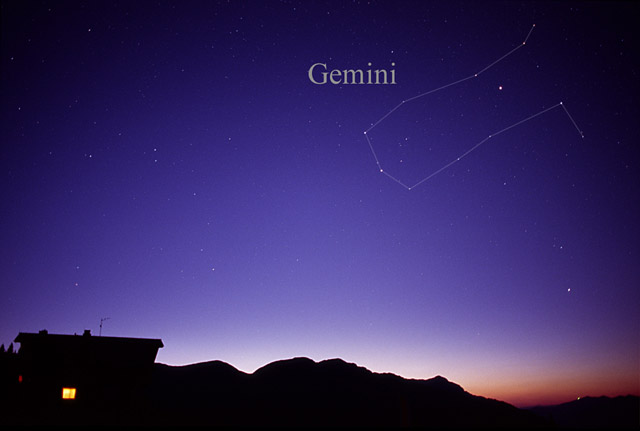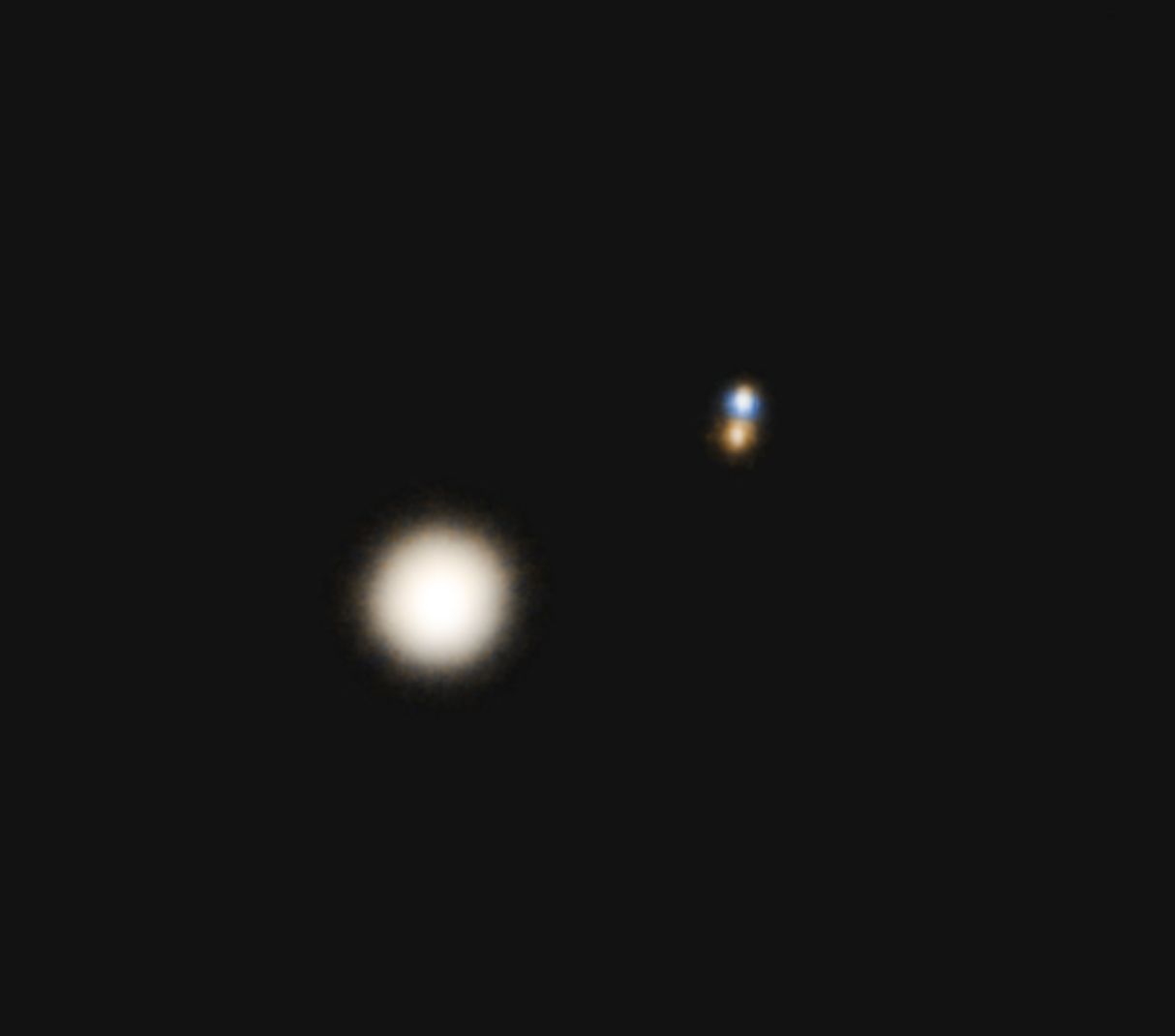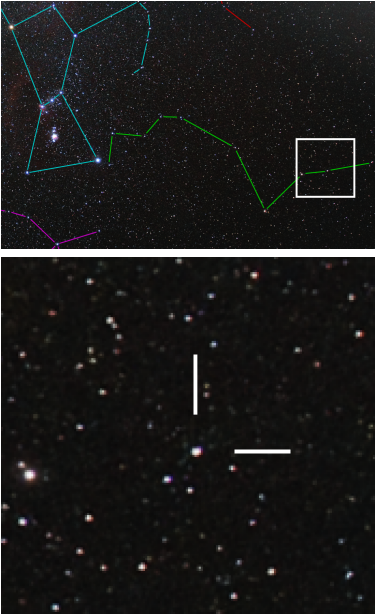|
Žü Geminorum
Rho Geminorum (Žü Gem) is a star system that lies 59 light-years away in the constellation of Gemini (constellation), Gemini, about 5 degree (angle), degrees west of Castor (star), Castor. The system consists of a primary bright enough to be seen with the naked eye, a faint secondary which has rarely been observed even professionally, and a distant, somewhat bright tertiary which requires telescopic equipment for observation. Components Rho Geminorum A has a spectral type F0V, meaning that it is a main sequence that is over a thousand kelvins hotter, one-third more massive, two-thirds larger and five-and-a-half times more luminous than the Sun. With an apparent magnitude of 4.25, it is approximately the List of stars in Gemini, seventeenth-brightest star in the constellation of Gemini. The WDS lists four companions to Rho Geminorum A. Of these, surprisingly little is known about the closest companion, the magnitude 12.5 Rho Geminorum B. The most recent measurement ... [...More Info...] [...Related Items...] OR: [Wikipedia] [Google] [Baidu] |
Gemini (constellation)
Gemini is one of the constellations of the zodiac and is located in the northern celestial hemisphere. It was one of the 48 constellations described by the 2nd century AD astronomer Ptolemy, and it remains one of the 88 modern constellations today. Its name is Latin for ''twins'', and it is associated with the twins Castor and Pollux in Greek mythology. Its old astronomical symbol is (ŌÖŖ’ĖÄ). Location Gemini lies between Taurus (constellation), Taurus to the west and Cancer (constellation), Cancer to the east, with Auriga (constellation), Auriga and Lynx (constellation), Lynx to the north, Monoceros (constellation), Monoceros and Canis Minor to the south, and Orion (constellation), Orion to the south-west. In classical antiquity, Cancer was the location of the Sun on the June solstice, northern solstice (June 21). During the first century AD, axial precession shifted it into Gemini. In 1990, the location of the Sun at the northern solstice moved from Gemini into Taurus, wh ... [...More Info...] [...Related Items...] OR: [Wikipedia] [Google] [Baidu] |
List Of Stars In Gemini
This is the list of notable stars in the constellation A constellation is an area on the celestial sphere in which a group of visible stars forms Asterism (astronomy), a perceived pattern or outline, typically representing an animal, mythological subject, or inanimate object. The first constellati ... Gemini, sorted by decreasing brightness. See also * List of stars by constellation References * * * * {{DEFAULTSORT:List of stars in Gemini *List Gemini ... [...More Info...] [...Related Items...] OR: [Wikipedia] [Google] [Baidu] |
Durchmusterung Objects
In astronomy, Durchmusterung or Bonner Durchmusterung (BD) is an astrometric star catalogue of the whole sky, published by the Bonn Observatory in Germany from 1859 to 1863, with an extension published in Bonn in 1886. The name comes from ('run-through examination'), a German word used for a systematic survey of objects or data. The term has sometimes been used for other astronomical surveys, including not only stars, but also the search for other celestial objects. Special tasks include celestial scanning in electromagnetic spectrum, electromagnetic wavelengths shorter or longer than visible light waves. Original catalog The Bonner Durchmusterung (abbreviated BD), was initiated by Friedrich Wilhelm Argelander, Friedrich Argelander and using observations largely carried out by his assistants, which resulted in a catalogue of the positions and apparent magnitudes of 342,198 stars down to approximate apparent magnitude 9.5 and covering the sky from 90┬░N to 2┬░S declination. The cat ... [...More Info...] [...Related Items...] OR: [Wikipedia] [Google] [Baidu] |
Gliese And GJ Objects
Gliese may refer to: * Rochus Gliese (1891ŌĆö1978), a German actor, director, production designer, and art director * Wilhelm Gliese (1915ŌĆō1993), a German astronomer, best known for the Gliese Catalogue of Nearby Stars * Gliese Catalogue of Nearby Stars, a modern star catalog of stars located within 25 parsecs of the Earth ** Any of the stars in this catalog; see :Gliese and GJ objects {{Disambiguation, surname ... [...More Info...] [...Related Items...] OR: [Wikipedia] [Google] [Baidu] |
Hipparcos Objects
''Hipparcos'' was a scientific satellite of the European Space Agency (ESA), launched in 1989 and operated until 1993. It was the first space experiment devoted to precision astrometry, the accurate measurement of the positions and distances of celestial objects on the sky. This permitted the first high-precision measurements of the luminosity, intrinsic brightnesses, proper motions, and parallaxes of stars, enabling better calculations of their distance and tangential velocity. When combined with radial velocity measurements from spectroscopy, astrophysicists were able to finally measure all six quantities needed to determine the motion of stars. The resulting ''Hipparcos Catalogue'', a high-precision catalogue of more than 118,200 stars, was published in 1997. The lower-precision ''Tycho Catalogue'' of more than a million stars was published at the same time, while the enhanced Tycho-2 Catalogue of 2.5 million stars was published in 2000. ''Hipparcos'' follow-up mission, ''Gaia ... [...More Info...] [...Related Items...] OR: [Wikipedia] [Google] [Baidu] |
Henry Draper Catalogue Objects
Henry may refer to: People and fictional characters * Henry (given name), including lists of people and fictional characters * Henry (surname) * Henry, a stage name of Fran├¦ois-Louis Henry (1786ŌĆō1855), French baritone Arts and entertainment * Henry (2011 film), ''Henry'' (2011 film), a Canadian short film * Henry (2015 film), ''Henry'' (2015 film), a virtual reality film * ''Henry: Portrait of a Serial Killer'', a 1986 American crime film * Henry (comics), ''Henry'' (comics), an American comic strip created in 1932 by Carl Anderson * "Henry", a song by New Riders of the Purple Sage Places Antarctica * Henry Bay, Wilkes Land Australia *Henry River (New South Wales) *Henry River (Western Australia) Canada * Henry Lake (Vancouver Island), British Columbia * Henry Lake (Halifax County), Nova Scotia * Henry Lake (District of Chester), Nova Scotia New Zealand * Lake Henry (New Zealand) * Henry River (New Zealand) United States * Henry, Illinois * Henry, Indiana * Henry, Nebras ... [...More Info...] [...Related Items...] OR: [Wikipedia] [Google] [Baidu] |
Bayer Objects
Bayer AG (English: , commonly pronounced ; ) is a German multinational pharmaceutical and biotechnology company and is one of the largest pharmaceutical companies and biomedical companies in the world. Headquartered in Leverkusen, Bayer's areas of business include: pharmaceuticals, consumer healthcare products, agricultural chemicals, seeds and biotechnology products. The company is a component of the EURO STOXX 50 stock market index. Bayer was founded in 1863 in Barmen as a partnership between dye salesman Friedrich Bayer (1825ŌĆō1880) and dyer Friedrich Weskott (1821ŌĆō1876). The company was established as a dyestuffs producer, but the versatility of aniline chemistry led Bayer to expand its business into other areas. In 1899, Bayer launched the compound acetylsalicylic acid under the trademarked name Aspirin. Aspirin is on the World Health Organization's List of Essential Medicines. In 2021, it was the 34th most commonly prescribed medication in the United State ... [...More Info...] [...Related Items...] OR: [Wikipedia] [Google] [Baidu] |
White Dwarf
A white dwarf is a Compact star, stellar core remnant composed mostly of electron-degenerate matter. A white dwarf is very density, dense: in an Earth sized volume, it packs a mass that is comparable to the Sun. No nuclear fusion takes place in a white dwarf; what light it radiates is from its residual heat. The nearest known white dwarf is Sirius B, at 8.6 light years, the smaller component of the Sirius binary star. There are currently thought to be eight white dwarfs among the hundred star systems nearest the Sun. The unusual faintness of white dwarfs was first recognized in 1910. The name ''white dwarf'' was coined by Willem Jacob Luyten in 1922. White dwarfs are thought to be the final stellar evolution, evolutionary state of stars whose mass is not high enough to become a neutron star or black hole. This includes over 97% of the stars in the Milky Way. After the hydrogen-stellar nucleosynthesis, fusing period of a main sequence, main-sequence star of Stellar mass, lo ... [...More Info...] [...Related Items...] OR: [Wikipedia] [Google] [Baidu] |
40 Eridani
40 Eridani is a triple star system in the constellation of Eridanus, abbreviated 40 Eri. It has the Bayer designation Omicron2 Eridani, which is Latinized from ╬┐2 Eridani and abbreviated Omicron2 Eri or ╬┐2 Eri. Based on parallax measurements taken by the Gaia mission, it is about 16.3 light-years from the Sun. The primary star of the system, designated 40 Eridani A and named Keid, is easily visible to the naked eye. It is orbited by a binary pair whose two components are designated 40 Eridani B and C, and which were discovered on January 31, 1783, by William Herschel. It was again observed by Friedrich Struve in 1825 and by Otto Struve in 1851. In 1910, it was discovered that although component B was a faint star, it was white in color. This meant that it had to be a small star; in fact it was a white dwarf, the first discovered.''White Dwarfs'', E. Schatzman, Amsterdam: North-Holland, 1958. , p. 1 Although it is neither the closest white dwarf, nor the ... [...More Info...] [...Related Items...] OR: [Wikipedia] [Google] [Baidu] |
Epsilon Eridani
Epsilon Eridani ( Latinized from ╬Ą Eridani), proper name Ran, is a star in the southern constellation of Eridanus. At a declination of ŌłÆ9.46┬░, it is visible from most of Earth's surface. Located at a distance from the Sun, it has an apparent magnitude of 3.73, making it the third-closest individual star (or star system) visible to the naked eye. The star is estimated to be less than a billion years old. This relative youth gives Epsilon Eridani a higher level of magnetic activity than the Sun, with a stellar wind 30 times as strong. The star's rotation period is 11.2 days at the equator. Epsilon Eridani is smaller and less massive than the Sun, and has a lower level of elements heavier than helium. It is a main-sequence star of spectral class K2, with an effective temperature of about , giving it an orange hue. It is a candidate member of the Ursa Major moving group of stars, which share a similar motion through the Milky Way, implying these stars shared a ... [...More Info...] [...Related Items...] OR: [Wikipedia] [Google] [Baidu] |
Starspot
Starspots are stellar phenomena, so-named by analogy with sunspots. Spots as small as sunspots have not been detected on other stars, as they would cause undetectably small fluctuations in brightness. The commonly observed starspots are in general much larger than those on the Sun: up to about 30% of the stellar surface may be covered, corresponding to starspots 100 times larger than those on the Sun. Detection and measurements To detect and measure the extent of starspots one uses several types of methods. *For rapidly rotating stars ŌĆō Doppler imaging and Zeeman-Doppler imaging. With the Zeeman-Doppler imaging technique the direction of the magnetic field on stars can be determined since spectral lines are split according to the Zeeman effect, revealing the direction and magnitude of the field. *For slowly rotating stars ŌĆō Line Depth Ratio (LDR). Here one measures two different spectral lines, one sensitive to temperature and one which is not. Since starspots have a low ... [...More Info...] [...Related Items...] OR: [Wikipedia] [Google] [Baidu] |
Stellar Parallax
Stellar parallax is the apparent shift of position (''parallax'') of any nearby star (or other object) against the background of distant stars. By extension, it is a method for determining the distance to the star through trigonometry, the stellar parallax method. Created by the different orbital positions of Earth, the extremely small observed shift is largest at time intervals of about six months, when Earth arrives at opposite sides of the Sun in its orbit, giving a baseline (the shortest side of the triangle made by a star to be observed and two positions of Earth) distance of about two astronomical units between observations. The parallax itself is considered to be half of this maximum, about equivalent to the observational shift that would occur due to the different positions of Earth and the Sun, a baseline of one astronomical unit (AU). Stellar parallax is so difficult to detect that its existence was the subject of much debate in astronomy for hundreds of years. Thomas ... [...More Info...] [...Related Items...] OR: [Wikipedia] [Google] [Baidu] |





